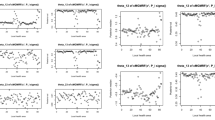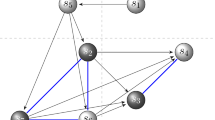Abstract
This paper presents an original ABC algorithm, ABC Shadow, that can be applied to sample posterior densities that are continuously differentiable. The proposed algorithm solves the main condition to be fulfilled by any ABC algorithm, in order to be useful in practice. This condition requires enough samples in the parameter space region, induced by the observed statistics. The algorithm is tuned on the posterior of a Gaussian model which is entirely known, and then, it is applied for the statistical analysis of several spatial patterns. These patterns are issued or assumed to be outcomes of point processes. The considered models are: Strauss, Candy and area-interaction.








Similar content being viewed by others
References
Atchadé, Y.F., Lartillot, N., Robert, C.P.: Bayesian computation for statistical models with intractable normalizing constants. Braz. J. Probab. Stat. 27(4), 416–436 (2013)
Baddeley, A.J., van Lieshout, M.N.M.: Area-interaction point processes. Ann. Inst. Stat. Math. 47, 601–619 (1995)
Baddeley, A.J., Silverman, B.W.: A cautionary example on the use of second-order methods for analyzing point patterns. Biometrics 40, 1089–1093 (1984)
Beaumont, M.A., Cornuet, J.M., Marin, J.-M., Robert, C.P.: Adaptative approximate bayesian computation. Biometrika 96(4), 983–990 (2009)
Bedford, T., van den Berg, J.: A remark on the Van Lieshout and Baddeley J function for point processes. Adv. Appl. Probab. SGSA 29(1), 19–25 (1997)
Biau, G., Cérou, F., Guyader, A.: New insights into approximate bayesian computation. Ann. Inst. Henri Poincaré Prob. Stat. 51(1), 376–403 (2015)
Blum, M.G.B.: Approximate bayesian computation: a nonparametric perspective. J. Am. Stat. Assoc. 105(491), 1178–1187 (2010)
Grelaud, A., Robert, C.P., Marin, J.M., Rodolphe, F., Taly, J.F.: ABC likelihood-free methods for model choice in Gibbs random fields. Bayesian Anal. 4(2), 317–336 (2009)
Kelly, F.P., Ripley, B.D.: A note on Strauss’s model for clustering. Biometrika 63(2), 357–360 (1976)
Marin, J.M., Pudlo, P., Robert, C.P., Ryder, R.J.: Approximate bayesian computational methods. Stat. Comput. 22(6), 1167–1180 (2012)
Martinez, V.J., Saar, E.: Statistics of the Galaxy Distribution. Chapman & Hall, London (2002)
Meyn, S., Tweedie, R.L.: Markov Chains and Stochastics Stability. Cambridge University Press, Cambridge (2009)
Møller, J., Pettitt, A.N., Reeves, R.W., Berthelsen, K.K.: An efficient Markov chain Monte Carlo method for distributions with intractable normalizing constants. Biometrika 93, 451–458 (2006)
Møller, J., Waagepetersen, R.P.: Statistical Inference and Simulation for Spatial Point Processes. Chapman and Hall/CRC, Boca Raton (2004)
Myllymäki, M., Mrkvička, T., Grabarnik, P., Seijo, H., Hahn, U.: Global envelope tests for spatial processes. J. R. Stat. Soc. B (forthcoming)
Stoica, RS., Tempel, E., Liivamägi, LJ., Castellan, G., Saar, E.: Spatial patterns analysis in cosmology based on marked point processes. In: For Astrophysics Methods S, Applications of the Regression. Statistics for astrophysics. Methods and applications of the regression, European Astronomical Society Publication Series, EDP Sciences (2015)
Stoica, R.S., Descombes, X., Zerubia, J.: A Gibbs point process for road extraction in remotely sensed images. Int. J. Comput. Vis. 57, 121–136 (2004)
Stoica, R.S., Gregori, P., Mateu, J.: Simulated annealing and object point processes: tools for analysis of spatial patterns. Stoch. Process. Appl. 115, 1860–1882 (2005)
Strauss, D.J.: A model for clustering. Biometrika 62, 467–475 (1975)
Tierney, L.: Markov chains for exploring posterior distribution (with discussion). Ann. Stat. 22(4), 1701–1762 (1994)
Winkler, G.: Image Analysis, Random Fields and Markov Chain Monte Carlo Methods, 2nd edn. Springer (2003)
van Lieshout, M.N.M.: Markov Point Processes and Their Applications. Imperial College Press, London (2000)
van Lieshout, M.N.M., Stoica, R.S.: The Candy model revisited: properties and inferencea. Stat. Neerlandica 57, 1–30 (2003)
Acknowledgments
This work was initiated during stays of the first author at University Jaume I and INRA Avignon. The first author is grateful to D. Allard, Yu. Davydov, M. N. M. van Lieshout, J. Møller, E. Saar and the members of the Working Group “Stochastic Geometry” of the University of Lille, for useful comments and discussions. The work of the first author was partially supported by the GDR GEOSTO project. P. Gregori and J. Mateu were supported by Grants P1-1B2012-52 and MTM2013-43917-P.
Author information
Authors and Affiliations
Corresponding author
Appendix: Proof of the results
Appendix: Proof of the results
1.1 Proof of Theorem 1
-
(i)
Both density functions vanish outside \(b(\theta , \varDelta /2)\). For \(\psi \in b(\theta , \varDelta /2)\), the integral mean value theorem applied to the denominator of \(q_\varDelta \) leads to
$$\begin{aligned} \quad q_\varDelta (\theta \rightarrow \psi ) = \frac{ \frac{f(\mathbf{x}|\psi )}{c(\psi )} }{ V_\varDelta \frac{f(\mathbf{x}|\theta ^*)}{c(\theta ^*)} } \end{aligned}$$for some \(\theta ^* \in b(\theta , \varDelta /2)\). The positivity and the continuity of the density p (uniform continuity indeed, since \(\varTheta \) is compact) allows us to do the following. Let \(m(\mathbf{x}) := \inf _{\phi \in \varTheta } p(\mathbf{x}| \phi ) > 0\) since it is actually a minimum. For \(A \in \mathcal{T}_{\varTheta }\) we have
$$\begin{aligned}&\int _A \left| q_{\varDelta }( \theta \rightarrow \psi ) - U_{\varDelta }( \theta \rightarrow \psi ) \right| \hbox {d}\psi \\&\quad = \int _{A \cap b(\theta , \varDelta /2))} \left| \frac{\frac{f(\mathbf{x}|\psi )}{c(\psi )} }{ V_{\varDelta } \frac{f(\mathbf{x}|\theta ^*)}{c(\theta ^*)} } - \frac{1}{V_\varDelta } \right| \hbox {d}\psi \\&\quad \le \frac{1}{V_\varDelta }\sup _{\phi \in \varTheta } \frac{c(\phi )}{f(\mathbf{x}|\phi )} \int _{A \cap b(\theta , \varDelta /2)} \\&\qquad \times \left| \frac{f(\mathbf{x}|\psi )}{c(\psi )} - \frac{f(\mathbf{x}|\theta ^*)}{c(\theta ^*)} \right| \hbox {d} \psi \\&\quad \le \frac{\mu (A \cap b(\theta , \varDelta /2))}{V_\varDelta } m(\mathbf{x})^{-1} \\&\quad \quad \times \sup _{\hbox {d}(\psi , \theta ^*)< \varDelta } \left| \frac{f(\mathbf{x}|\psi )}{c(\psi )} - \frac{f(\mathbf{x}|\theta ^*)}{c(\theta ^*)} \right| \\&\quad \le m(\mathbf{x})^{-1} \sup _{\hbox {d}(\psi , \theta ^*) < \varDelta } \left| \frac{f(\mathbf{x}|\psi )}{c(\psi )} - \frac{f(\mathbf{x}|\theta ^*)}{c(\theta ^*)} \right| \end{aligned}$$where the last supremum is independent of \(\psi \) and \(\theta ^*\), and approaches to 0 as far as \(\varDelta \) does. With the regularity condition on \(p(\mathbf{x}|\cdot )\), we can tune up the inequality, using the (differential) mean value theorem, to
$$\begin{aligned} \int _A&\left| q_{\varDelta }( \theta \rightarrow \psi ) - U_{\varDelta }( \theta \rightarrow \psi ) \right| \hbox {d} \psi \\&\quad \le m(\mathbf{x})^{-1} \varDelta \sup _{\psi ^* \in \varTheta } \left\| D_{\varTheta } p(\mathbf{x}|\psi ^*) \right\| \\&\quad := C_1(\mathbf{x}, p, \varTheta ) \varDelta \end{aligned}$$where \(C_1(\mathbf{x}, p, \varTheta )\) is a constant depending on \(\mathbf{x},p\) and \(\varTheta \).
-
(ii)
As previously, the use of the integral mean value theorem gives the result, since
$$\begin{aligned}&\sup _{\psi \in \varTheta } \left| \frac{q_\varDelta (\theta \rightarrow \psi | \mathbf{x})}{q_\varDelta (\psi \rightarrow \theta | \mathbf{x})} - \frac{ \frac{f(\mathbf{x}|\psi )}{c(\psi )}\mathbf{1}_{b(\theta ,\varDelta /2)}(\psi ) }{ \frac{f(\mathbf{x}|\theta )}{c(\theta )}\mathbf{1}_{b(\psi ,\varDelta /2)}(\theta ) } \right| \\&\quad \le \sup _{\psi \in b(\theta ,\varDelta /2)} \left| \frac{ \frac{f(\mathbf{x}|\psi )}{c(\psi )} / (V_\varDelta \frac{f(\mathbf{x}|\theta ^*)}{c(\theta ^*)}) }{ \frac{f(\mathbf{x}|\theta )}{c(\theta )} / (V_\varDelta \frac{f(\mathbf{x}|\psi ^*)}{c(\psi ^*)}) } - \frac{ \frac{f(\mathbf{x}|\psi )}{c(\psi )} }{ \frac{f(\mathbf{x}|\theta )}{c(\theta )} } \right| \\&\quad \le \sup _{\psi \in b(\theta ,\varDelta /2)} \left| \frac{ \frac{f(\mathbf{x}|\psi )}{c(\psi )} }{ \frac{f(\mathbf{x}|\theta )}{c(\theta )} } \right| \left| \frac{ \frac{f(\mathbf{x}|\psi ^*)}{c(\psi ^*)} }{ \frac{f(\mathbf{x}|\theta ^*)}{c(\theta ^*)} } - 1 \right| \\ \le&M(\mathbf{x}) m(\mathbf{x})^{-2} \sup _{d(\theta ^*,\psi ^*) \le \varDelta } \left| \frac{f(\mathbf{x}|\psi ^*)}{c(\psi ^*)} - \frac{f(\mathbf{x}|\theta ^*)}{c(\theta ^*)} \right| \end{aligned}$$where \(M(\mathbf{x}) := \sup _{\phi \in \varTheta } p(\mathbf{x}| \theta ) < \infty \) is a maximum and \(\theta ^* \in b(\theta , \varDelta /2)\), \(\psi ^* \in b(\psi , \varDelta /2)\) are obtained from the integral mean value theorem. As in (i), under the regularity condition on \(p(\mathbf{x}|\cdot )\), this inequality can evolve to
$$\begin{aligned}&\sup _{\psi \in \varTheta } \left| \frac{q_\varDelta (\theta \rightarrow \psi | \mathbf{x})}{q_\varDelta (\psi \rightarrow \theta | \mathbf{x})} - \frac{ \frac{f(\mathbf{x}|\psi )}{c(\psi )}\mathbf{1}_{b(\theta ,\varDelta /2)}(\psi ) }{ \frac{f(\mathbf{x}|\theta )}{c(\theta )}\mathbf{1}_{b(\psi ,\varDelta /2)}(\theta ) } \right| \\&\quad \le M(\mathbf{x}) m(\mathbf{x})^{-2} \varDelta \sup _{\psi ^* \in \varTheta } \left\| D_{\varTheta } p(\mathbf{x}|\psi ^*) \right\| \\&\quad := C_2(\mathbf{x}, p, \varTheta ) \varDelta \end{aligned}$$where \(C_2(\mathbf{x}, p, \varTheta )\) is a constant depending on \(\mathbf{x},p\) and \(\varTheta \).
1.2 Proof of Proposition 1
If \(n = 1\), the definition of the transition kernels, the introduction of the term \(U_\varDelta (\theta \rightarrow \psi ) \alpha _i(\theta \rightarrow \psi ) - U_\varDelta (\theta \rightarrow \psi ) \alpha _i(\theta \rightarrow \psi )\), then the use of the triangle’s inequality and also the boundedness of functions \(1_{A}(\cdot )\), \(\alpha _i(\cdot )\) and \(\alpha _s(\cdot )\) allow us to write
Under the hypothesis of Theorem 1, and then applying Theorem 1(i) and Corollary 1, the transition kernels of the ideal and the shadow Markov chains, respectively, are uniformly close as well (say for any \(\epsilon > 0\), there exists \(\varDelta (\epsilon ,1) > 0\) such that we have \(| P_s(\theta ,A) - P_i(\theta ,A) | < \epsilon \) if \(\varDelta \le \varDelta (\epsilon ,1)\), independently of \(\theta \) and A).
If \(p(\mathbf{x}|\cdot ) \in \mathcal{C}^1(\varTheta )\), then the previous inequalities can be completed to
giving a candidate expression for \(\varDelta _0(\epsilon , 1) := C_4(\mathbf{x}, p, \varTheta ) \epsilon \). The constants \(C_3\) and \(C_4\) depend on \(\mathbf{x},p\) and \(\varTheta \).
For \(n > 1\), we get by induction that
uniformly in \(\theta \) and A for all \(\varDelta \) such that
Rights and permissions
About this article
Cite this article
Stoica, R.S., Philippe, A., Gregori, P. et al. ABC Shadow algorithm: a tool for statistical analysis of spatial patterns. Stat Comput 27, 1225–1238 (2017). https://doi.org/10.1007/s11222-016-9682-x
Received:
Accepted:
Published:
Issue Date:
DOI: https://doi.org/10.1007/s11222-016-9682-x




